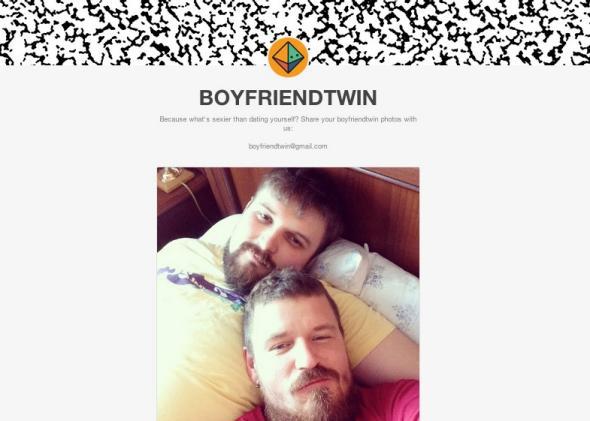They have matching puffed-out chests, green plaid shirts, and endearing bedhead. Their facial hair was carved by the same blade. When they kiss, they look like they’re doing an especially salacious rendition of the Marx Brothers mirror routine. Forget the homonymous gay couples, with their quaint troubles of shared first names and confused friends. Behold the boyfriend twin.
As the Tumblr that appeared recently asks, “What’s sexier than dating yourself?” Boyfriend Twin’s ever-growing scroll of photos seems to have charmed and terrified its devoted audience in equal measure, scratching at unconscious fears about how we choose our mates. In one portrait after another, two men with similar expressions pose for the camera with complementary profiles that match all the way down to the chest hair. Straight couples who are confused for siblings have been ticklish fodder for lifestyle stories for years, but the boyfriend twins take that a step further, suggesting that what we’re really searching for is our own romantic clone.
This anxiety, of course, long predates the Tumblr, as its anonymous creator has acknowledged, telling BuzzFeed loftily that the photos are intended to spark a conversation about “narcissism, exhibitionism, and sexuality.” For every gay guy who laughs it off, the boyfriend twin is another one’s worst fear realized. One Slate colleague told me his partner will demand a wardrobe change if the two men so much as wear the same fabric on the same day. His fear? “It confirms the whole dumb Freudian model of homosexuality as a kind of narcissism.” Is that really it? Is the lookalike lover a symptom of excessive self-regard, or is it something more elusive?
The answer depends on whom you ask, and there’s plenty of disagreement, even among people who make a living studying such things. But two things are clear: This phenomenon is not particular to gay men, and people do tend to be drawn sexually to people who look similar to them. The real question is why and how that works.
“There’s a lot of work suggesting that people are, in fact, attracted to people who look like them, and this is true over a wide swath of characteristics, from physical characteristics to morals and religious characteristics,” says R. Chris Fraley, a professor of psychology at the University of Illinois at Urbana-Champaign. His research included a study that morphed a subject’s face into the face of a stranger, then asked the subject to evaluate the resulting face’s attractiveness on a computer screen. Sure enough, subjects favored faces that included their own features. Fraley thinks this tendency traces back to the environment where we grew up and points to preliminary findings about race and attractiveness: People reared in more racially diverse environments appear more likely to find people of other races attractive than people who grew up in racially homogeneous environments. (Though much of the research in this area focuses on opposite-sex attraction, Fraley says he’s found no reason to assume this system works differently for gay men.)
Debra Lieberman, an assistant professor at the University of Miami, is skeptical of facial-recognition theories, but she agrees that there’s an underlying mechanism that leads people to date others who look similar to them. She refers to what she calls “template formation,” or the assembly of traits we learn to look for in romantic partners when we’re young. “The information is not genetically stored, because you can learn it socially every generation,” she says. “Family members, by virtue of the fact that you’re around them so much when you’re young, they fill out that template.” So in Lieberman’s view, the boyfriend twins might not really want to date themselves—they want to date men who have similar attributes as their paternal figures growing up. Does that comfort you?
It’s worth emphasizing that such connections go far beyond physical appearance. Another researcher pointed me to the charmingly titled paper “How Do I Love Thee? Let Me Count the Js: Implicit Egotism and Interpersonal Attraction,” which found that people are more likely to be drawn to others who share factors as superficial as similar birthdays and common letters in surnames. The full paper is well worth a read, if only for the surprising (and slightly depressing) conclusions it draws about how our decisions can be unconsciously influenced by the most mundane of personal factors.
Given all this, it’s easy to understand why our first reaction to the boyfriend twins Tumblr is some version of “We don’t know how to feel about this.” But we can rest assured that our complex romantic palates can’t be reduced too neatly. Many of the Tumblr’s more provocative photos strike me as performance art, the couple deliberately drawing on “twincest” taboos to make a humorous point about how much they look alike—and that seems like a more reasonable approach than making your boyfriend avoid cashmere just because you’re wearing it. At least some of our ability to discriminate between partners appears to have been decided a long time ago, so we may as well embrace it. And happily, many of us are: The boyfriend twin photos keep pouring in.
Thanks to Paul Eastwick of the University of Texas at Austin.
